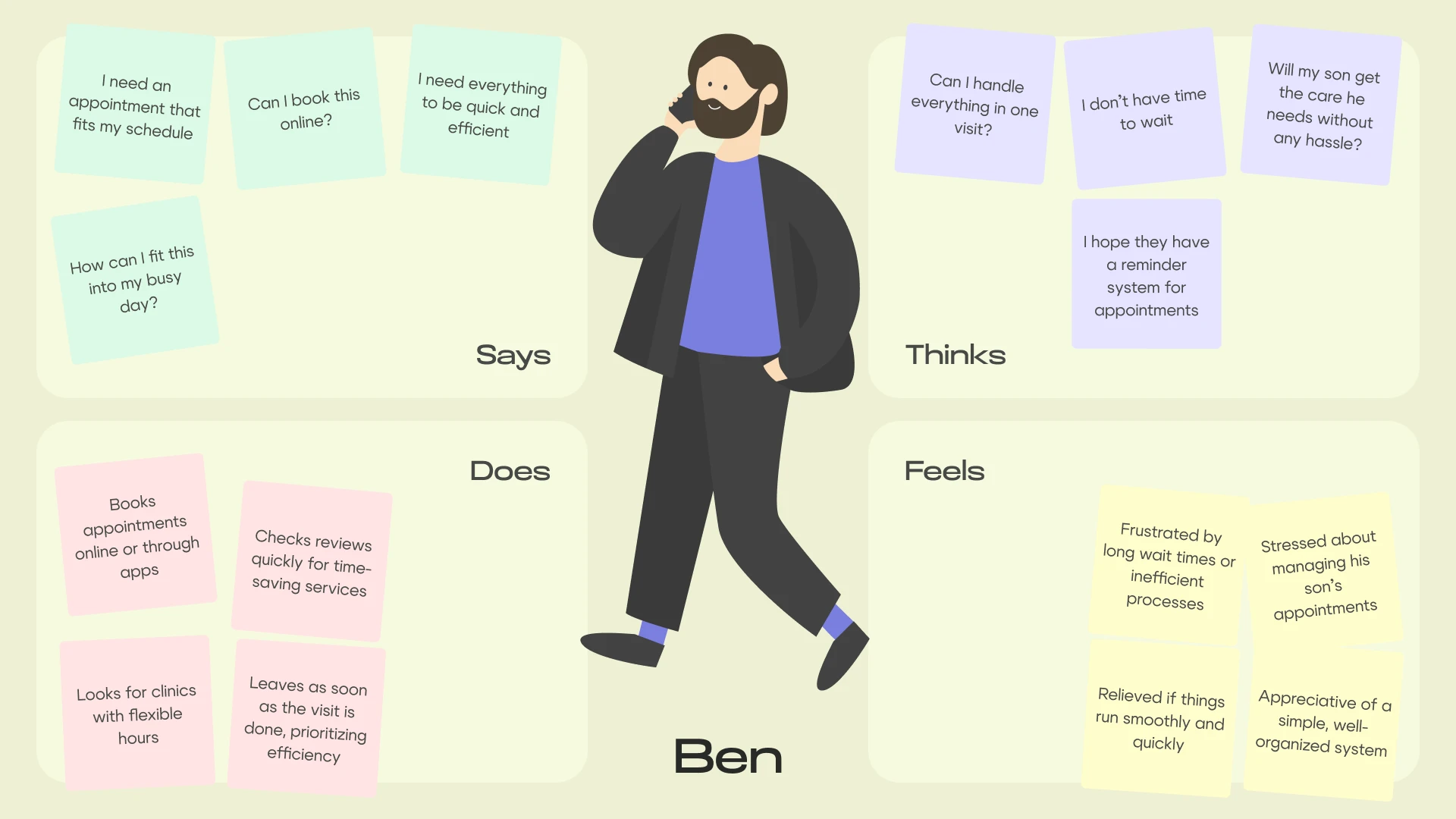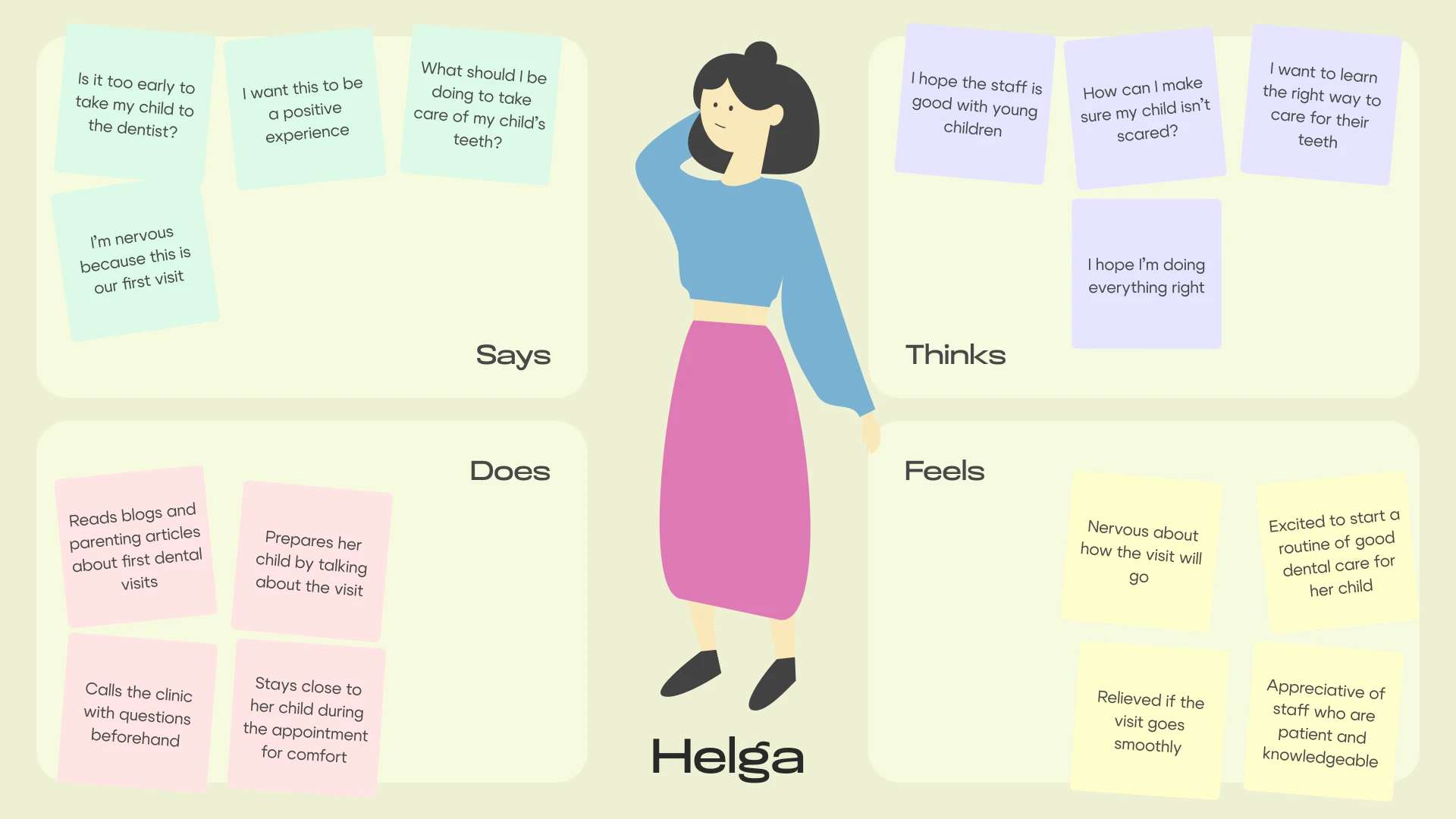
Understanding your audience is not just important — it’s fundamental. Personas, fictional yet realistic representations of your target humans, provide a lens through which you can view your services, helping you design with empathy and precision. By tailoring services to meet the specific needs of these personas, businesses can create meaningful, human-centric solutions.
Let’s explore the significance of personas in service design through the example of a pediatric dental clinic and two key personas: Ben, the Busy Dad, and Helga, a First-Time Mom.
Who Are Your Personas?
Ben, the Busy Dad
Ben is a father juggling work, family, and countless daily responsibilities. He struggles to find a pediatric dentist whose schedule aligns with his. While Ben wants the best care for his 9-year-old son, he needs a clinic that respects his time.
His pain points include:
- Limited availability for appointments during traditional working hours.
- Difficulty in keeping up with his son’s dental hygiene due to a packed schedule.
- Frustration with long wait times at clinics.
What Ben values:
- Flexible scheduling, including evenings and weekends.
- Clear and efficient communication (e.g., reminders and online appointment systems).
- Quick yet thorough dental visits.

Helga, the First-Time Mom
Helga is a new mom preparing for her toddler’s first dental visit. She’s anxious and wants to ensure a positive experience for her child. Her priorities include gaining knowledge about pediatric dental care and ensuring her child feels comfortable.
Her concerns include:
- Lack of knowledge about proper toddler dental hygiene.
- Fear of her child developing dental anxiety.
- Finding a clinic that is welcoming and educational.
What Helga Values:
- A friendly and patient-focused clinic atmosphere.
- Educative resources for first-time parents.
- A dentist who takes time to explain procedures and ease her worries.

Why Develop Personas?
1. Building Empathy
Personas like Ben and Helga help step into the shoes of real humans. They bring to life the diverse needs, goals, and pain points of your audience. By focusing on these personas, designers can create services that truly resonate.
For example:
- Recognising Ben’s packed schedule might inspire the clinic to offer early morning or late evening appointments.
- Understanding Helga’s anxiety may lead to the creation of a “First-Time Visit Guide” to educate and reassure parents.
2. Driving Patient-Centered Innovation
Personas ensure the design process remains grounded in real human needs. Instead of making assumptions, they push teams to ask, “What would Ben need in this situation?” or “How would Helga feel about this service?”
For example:
- Online booking systems and automated reminders could cater to Ben’s time management needs.
- Kid-friendly spaces and fun educational activities might appeal to Helga’s desire for a welcoming environment.
3. Streamlining Decision-Making
Clear personas act as a compass during the design process. They guide teams when prioritising features or resolving conflicting ideas. By referring back to personas, teams can evaluate ideas based on human relevance.
For instance:
- When deciding between adding a TV in the waiting room or extending operational hours, the team could prioritise extended hours, aligning with Ben’s needs.
Making Personas Actionable
Research
Create personas through real-world research, including interviews, observations, and surveys. This ensures accuracy and relevance.
Detailed Description
Each persona should be described in detail — including their needs, values, behaviors, and pain points. A well-crafted persona allows the entire team to clearly imagine the person and predict their actions in specific contexts.
Collaboration
Involve your entire team in persona development. Shared understanding leads to cohesive service design.
Iteration
Personas should evolve as new insights are gained. Regular updates ensure they stay aligned with your audience’s changing needs.
Conclusion
Personas are more than just profiles; they’re tools for empathy, innovation, and focus. For a pediatric dental clinic, designing with Ben and Helga in mind can lead to services that not only meet but exceed expectations. By addressing their unique concerns and values, the clinic can foster trust, loyalty, and satisfaction.
Developing personas is an investment in understanding — and understanding is the foundation of exceptional service design.


